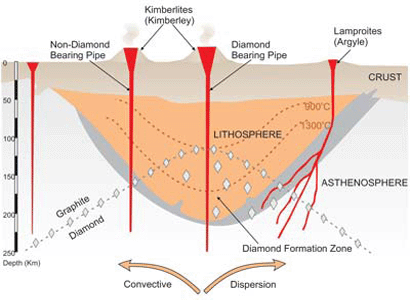Types of Diamond Deposits
Geologic processes produce two basic types of diamond deposits, referred to as primary and secondary sources. Primary sources are the kimberlite and lamproite pipes that raise diamonds from Earth's mantle, where they begin. Secondary sources, formed by erosion, include such deposits as surface scatterings around a pipe, concentrations in river channels, and fluxes from rivers moved by wave action along ocean coasts, past and present. Mining of these deposits depends upon adequate concentration and quality of diamonds.

The major deposits, or diamond pipes, are the vertical portion. The flared top of the pipes can yield substantial quantities of diamonds, but following the narrowing pipe downward finally becomes unprofitable. Note how erosion of the landscape moves surface minerals -- including the diamonds -- from the pipes down hills, streams, and rivers to their final destination, the ocean. Because diamonds are dense they focus at the bottom of active zones of moving sand and gravel. These minor deposits are eluvial &#eth; above a pipe, colluvial -- adjacent to a pipe, alluvial &#eth; stream and river transported, and marine -- along beaches that can wind up onshore or offshore with varying sea level. Secondary deposits may be found faraway from active means of transport, in the fossilized channels of now-vanished rivers or under fossil beaches.
<< Back | Next >>